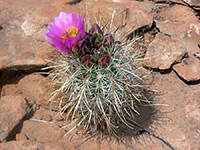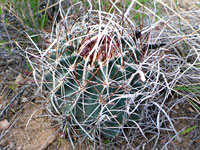Sclerocactus cacti resemble the echinocereus species but are usually single and have central spines that are hooked rather than straight, hence their common name of fishhook cactus. Spines grow from tubercles arranged in prominent ribs. Over a dozen different types have been identified, found in higher elevation desert regions, places not generally associated with cacti, hence the plants are not often spotted. Many species are quite rare and localized.
There are eight other US species:
Sclerocactus blainei, Blaine fishhook cactus, west Utah and east/central Nevada (rare)
Sclerocactus brevispinus, Pariette cactus, northeast Utah - Uinta Basin area (rare)
Sclerocactus glaucus, Colorado hookless cactus, west Colorado, between Grand Junction and Montrose (rare)
Sclerocactus nyensis, Nye County fishhook cactus, Nye and Esmeralda counties of Nevada (rare)
Sclerocactus pubispinus, Great Basin fishhook cactus, northeast Nevada and northwest Utah
Sclerocactus wetlandicus, Uinta Basin hookless cactus, northeast Utah (rare)
Sclerocactus whipplei, Whipple's fishhook cactus, southeast Utah and northeast Arizona
Sclerocactus wrightiae, Wright's fishhook cactus, east-central Utah (San Rafael Swell) (rare)
There are eight other US species:
Sclerocactus blainei, Blaine fishhook cactus, west Utah and east/central Nevada (rare)
Sclerocactus brevispinus, Pariette cactus, northeast Utah - Uinta Basin area (rare)
Sclerocactus glaucus, Colorado hookless cactus, west Colorado, between Grand Junction and Montrose (rare)
Sclerocactus nyensis, Nye County fishhook cactus, Nye and Esmeralda counties of Nevada (rare)
Sclerocactus pubispinus, Great Basin fishhook cactus, northeast Nevada and northwest Utah
Sclerocactus wetlandicus, Uinta Basin hookless cactus, northeast Utah (rare)
Sclerocactus whipplei, Whipple's fishhook cactus, southeast Utah and northeast Arizona
Sclerocactus wrightiae, Wright's fishhook cactus, east-central Utah (San Rafael Swell) (rare)
All Contents © Copyright The American Southwest | Comments and Questions | Contribute | Affiliate Marketing Disclosure | Site Map





